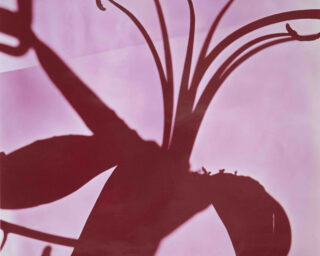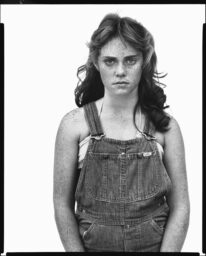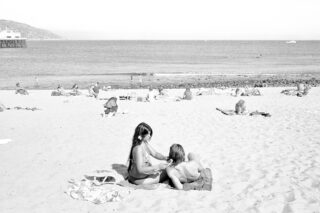America's Desert Dystopia
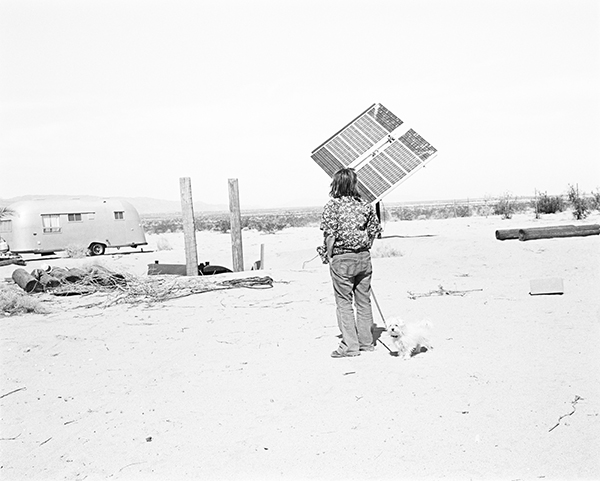
Susan Lipper, Untitled, from the book Domesticated Land, 2018
Courtesy the artist and Higher Pictures, New York
The American desert has always been contested and occupied. Full of masculine self-aggrandizement, the stories Americans tell themselves about these landscapes and their past do little to clarify matters. Despite the belief otherwise, the desert is not a clean slate that absorbs the sins of America. Atom bombs, genocidal slaughter, military exercises and secrets are all reduced to dots on a map, hidden in the expansive terrain, but their erasure is never complete. Constructed from a pointedly feminist perspective, Susan Lipper’s Domesticated Land (MACK, 2018) offers a subtle but insistent counternarrative. Lipper’s project shares an affinity with the diaries of women who traveled west in the nineteenth century, but also draws on the deep photographic history that has addressed the American desert, joining a long (and continuous) narrative of settlement and resistance in a hostile and alien landscape. What Lipper finds there is unsettling yet all too familiar, but she offers hope. That we’re not slaves to the narratives or aggressive forces surrounding us. That we can carve out a space amidst the madness and the stark light, a space we can cultivate and perhaps someday call a home.
Adam Bell: Domesticated Land is the final part of a trilogy that includes the books Grapevine (1994) and trip (1999). You’ve talked about how the three projects form a “synthetic road trip.” How did you come to see these projects as a trilogy? And what led you to the American desert?
Susan Lipper: I am taking some creative license. Although Grapevine and trip were basically consecutive, there is a thirteen-year gap before Domesticated Land starts. Some time after finishing Grapevine, I manufactured a photographic persona, and it is through her eyes that we see. Like myself, my persona is a liberal native New Yorker (but probably, as a more romantic type, doesn’t obsess over the news), looking for a reason to believe in the myth of new beginnings. She has not lost faith in America fulfilling its utopian promise—or at least in some regional or geographic part of it retaining the promise. She is also looking for something pure and viable outside of global consumerism and all-encroaching mainstream culture. This unrelenting search for freedom and transparency leads her to the West, as it has led Americans since the country’s inception. In addition, she is fascinated by the well-trodden, mostly male trope of the American road trip.

Susan Lipper, Untitled, from the book Domesticated Land, 2018
Courtesy the artist and Higher Pictures, New York
Bell: The American desert is a vast, complex landscape, often associated with Hollywood Westerns and other traditionally masculine narratives of conquest, settlement, and militarization. You shot these images primarily in the Southern California desert, east of LA and west of Las Vegas. What drew you to this particular American desert, and how do you see your work reacting to or pushing back against more dominant narratives of the U.S. desert and Western landscape?
Lipper: Deborah Bright, in her famous 1985 essay “Of Mother Nature and Marlboro Men,” threw down the gauntlet asking why “the art of landscape photography remains so singularly identified with a masculine eye,” and referring to the American landscape as “an exclusive white male preserve.” My interest was in revealing my persona’s subjective response to the California desert and in adding her voice to the canon. I believed this voice to be subversive and antipatriarchal. When researching, my only parameters were that I/my persona needed to be in California and the desert. What mattered was that California represented the end of the line both historically for emigration and also the end of the line, period. The desert too is obviously a very loaded metaphor. Sure, there are American and photographic references, but also less concrete ones that relate to the Bible and science fiction. It’s been said somewhere, I think by the theorist Dick Hebdige, that the desert continues to be a blank slate for multiple contradictory projections.
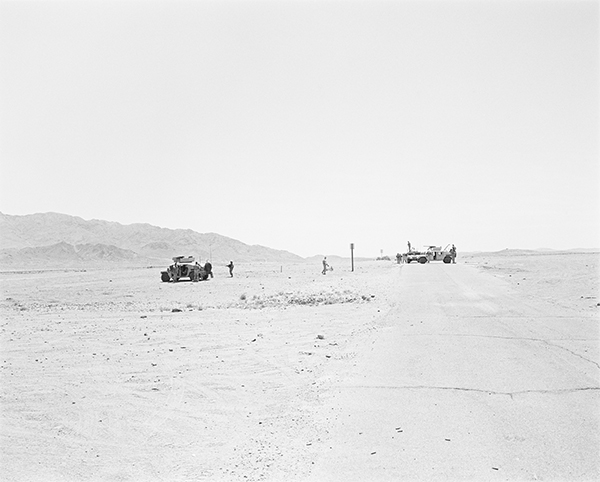
Susan Lipper, Untitled, from the book Domesticated Land, 2018
Courtesy the artist and Higher Pictures, New York
Bell: Although the landscapes appear empty at times, the spaces are full of people or human presence—abandoned foundations, piles of rusty food cans, solar panels, and, most dominantly, the U.S. military. While the U.S. military has long used the deserts of California and other western states as staging grounds for military exercises, civilians have also settled the landscape and sought to carve out a “domestic” space, to borrow a word from your title. One of the protagonists in the work appears to be a group of friends (or family) with a dog, who seem to be searching through the sparse settlements they find—looking for clues, or perhaps looking for a place to settle down. Contrasting images show large crowds moving towards a military base under the watchful guidance of men in desert fatigues, perhaps tacitly accepting the occupation, or their presence. How do you see these two impulses playing out in the work?
Lipper: One of the things I am playing with in Domesticated Land is a somewhat fantastical apocalyptic narrative, a bit like Stanley Kubrick’s 2001: A Space Odyssey, where there is a story told sequentially, but embellished by transhistorical leaps both forward and back. Besides asking the viewer to construct their own tale, I am also asking them to reject seeing only the descriptive power of the medium—the eternal and knowable present.
Additionally, embedded in Domesticated Land is a subplot featuring actual people, a rock band, who interacted with my persona—a family who took her in. This bonus content is a bit like finding an Easter egg in computer software. Awareness of these individuals might only emerge to the obsessed or careful reader after the multiple readings that are allowed and encouraged by the photobook format.
In the course of events, my persona comes to understand that the desert homesteader group/mankind is living on borrowed time, and that it is only military conglomerates or governmental forces that can assemble enough technology to sustainably survive the harsh conditions that exist in the desert/free world. The men in fatigues you mention represent those as-yet-undefined factions.

Susan Lipper, Untitled, from the book Domesticated Land, 2018
Courtesy the artist and Higher Pictures, New York
Bell: Despite the high-key light, there is an underlying darkness to the work. The light is unrelenting; it obscures details, burning them out, but also forcing us to pay attention. What drew you to the light in the desert? And what, if any, metaphoric role do you see it playing in the work?
Lipper: In the novel The Stranger, by Albert Camus, the hero, or antihero, commits a random murder solely because he has become disoriented by the elements, namely the extreme bright light. His exposure to the glaring whiteness creates some kind of psychic transformation, classified as neither good nor evil. Like famed mirages, things in the desert are not what they seem. I am also reminded of the surreal sun-drenched dueling scorpion scene that opens Luis Buñuel’s L’Age d’Or, where there is no explanation offered. La Jetée by Chris Marker also alternates between light and dark worlds, but does not give preference to either one.
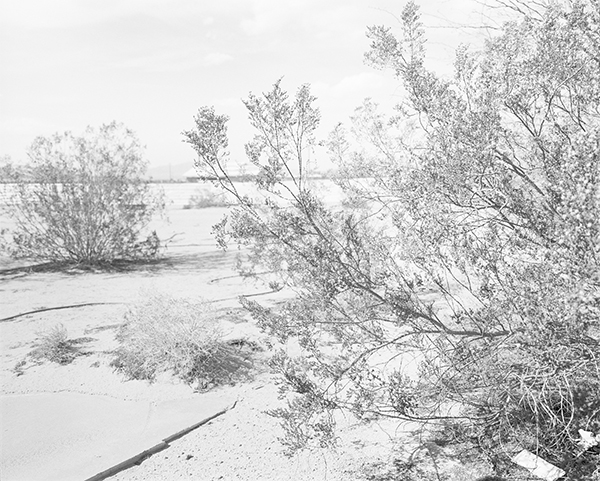
Susan Lipper, Untitled, from the book Domesticated Land, 2018
Courtesy the artist and Higher Pictures, New York
Bell: Your book is interspersed with several quotes by female authors—Margaret Atwood, the noted author; Annette Kolodny, an academic writing about female pioneers; and Catherine Haun, a woman from that period who wrote a diary. There are also lyrics from the rock band The Sibleys’ song “Cold Duck.” Can you talk a little about how you picked these quotes (and lyrics), their authors, and how you see them functioning in the book?
Lipper: The beginning and final passages pertain to largely forgotten female pioneers from the 1800s who kicked off my persona’s quest from the East to the West. These quotations are startlingly relevant today, especially when one considers that ours is still a broken and noncontiguous nation. As for Margaret Atwood, she popularized the term speculative fiction, tangible dystopian happenings in the near future that are not beyond imagining. The rock band’s lyrics, which one is presently able to listen to on Spotify and YouTube, frame a state of mind or vibe that embraces an inertia ubiquitous among current desert dwellers.
The texts and photographs are independent of each other and amongst themselves. Meaning is ordered in the mind of the reader. I suppose I was attempting to create a picture of ideas and emotions that were relevant in and around the time of the book’s assembling. I finished photographing in 2016, just before the U.S. election. The final edit and sequence took place during its aftermath.
Bell: The book ends on a slightly hopeful, albeit open-ended, note. The final sequence begins with an image shot from a window, looking past a curtain, out onto a sparsely inhabited landscape. The group of people we’ve been following may have found a spot to call their own, but may still be passing through, searching. What do you see as the trajectory of the book, and is the ending really an ending?
Lipper: The tale is meant to remain open-ended and be seen as a premonition relevant to these times. Though, it is not one without hope.






















